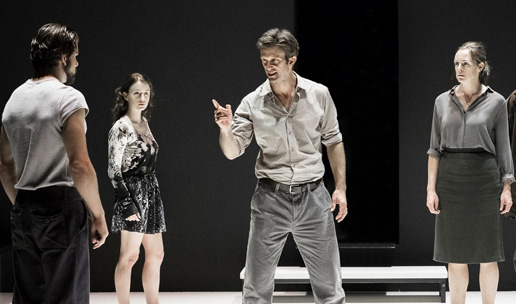
LOS ANGELES – To call Arthur Miller’s A View from the Bridge a loaded show would be all too accurate. The show is a Greek-style tragedy covering diverse issues including homoeroticism in a hyper-masculine proletariat, immigration to America and the implicit intergenerational politics of it, and the claustrophobic social constraints of poverty.
Written in 1956, as the playwright himself and many of his friends and colleagues were being summoned to testify before the House Committee on Un-American Activities, it is also a strong rebuke to informing as part of the emergent McCarthyite culture. The award-winning Young Vic production of this powerful show, now running at the Ahmanson Theatre, adeptly handles each of these issues with tactful passion.
This past June this same production deservedly took home two Tony awards. The first went to Belgian director Ivan van Hove for Best Direction of a Play. The second, for Best Revival of a Play, no doubt encapsulates the timely merits of this timeless play.
Miller stands as one of the giants of American playwriting. This play in particular, with its severe Greek tragedy genre, creates a daunting challenge for the artistic director. Van Hove’s Tony speaks to his ability in addressing these looming concerns. Set, lighting, costume, and sound design all coalesce and adhere to a single, coherent vision, which, if it could be captured in one word, would be austere.
Stage seating on two sides of the performing space creates a round, forum-style playing area. A solid black wall with a door-size cutout establishes the backdrop. To complete the square, a two-foot tall clear glass ledge surrounds the space, establishing the boundary between audience and performance. Throughout the show, the narrator, the Greek chorus in this case, straddles the glass boundary, serving not only as the eponymous metaphorical bridge, but also a physical one.
The characters all wear simple clothing, slacks and nondescript button-downs. This draws attention to the young Catherine (Catherine Combs) and her fledgling sexuality whenever she enters wearing the only remarkable outfit of the performance. Most compelling, though, each character inside the boundaries of the performance is noticeably barefoot. The stark contrast drawn between shoe-wearing theatre attendees and barefoot performers involves the audience in the show’s symbolism and commentary.
This production does not seek to reimagine the plot in any revolutionary way, and does not have to: the interpretation is enough. The show follows the story of the Carbone family and the interruption to their domestic life predicated by the arrival of immigrant cousins. The devolution of domestic tranquility into tragedy in this mid-20th-century Italian-American home marks a staple of the American dramatic canon.
The show shines most in its dual criticism and celebration of hyper-masculine proletarian physicality. The show opens on two men showering together after a long day of work, setting the tone for the rest of the show. The performance forgoes an intermission, but clearly marks the change in acts with a stark, celebratory presentation of proletarian masculinity.
The sole prop in the show, a simple chair, utilized in a key moment any fan of the play will be familiar with, enters in this transition between the acts. The hulking Marco (Alex Esola), with his barrel chest, lifts the simple object above him in Olympian, Thor-like fashion. The spotlight drops, and the audience stares for what feels like ages at the sheer strength of this worker. This unequivocally proves to be the most memorable moment of the show, and the height of its celebration of masculine strength. Moreover, this god-like imaging and focus on masculine ideals brings to mind the ancient-Greekness of this tragedy.
Yet homoeroticism and homophobia prove central themes of the show, bringing to mind a tension especially pertinent to the show’s particular setting, America in the 1950s. The unabashed paean to masculinity and the male form popularized by figures like Theodore Roosevelt (and for that matter, later on, the Nazis) carried with it an intense homophobia. Unprecedented dedication to the male form brought with it profound anxiety over the “right kind” of dedication to said form. How did this tension resolve in our national history? How does this tension resolve in the play? Better yet, has this tension been resolved?
The production again proves timely with its treatment of undocumented immigration. This production takes place during the ascendancy of a pernicious national xenophobia. A second theme deserves attention: The intergenerational conflicts between native-born descendants of immigrants and those “fresh off the boat” often do not receive adequate treatment. While in the play this issue comes off as incidental to the artistic aim of this specific production, the dynamic remains present.
This is a masterful rendition of an American classic, excellently suited to a contemporary audience. The much lauded production deserves the critical praise thrust upon it, and will surely leave viewers with a sober discussion to have on their way home. That, after all, served as the initial impetus for the Greeks to put tragedy onto the stage.
The Young Vic’s A View from the Bridge runs at the Ahmanson Theatre, 135 N. Grand Ave., Los Angeles 90012, through October 16, before heading to the Kennedy Center. A preview can be viewed at View from the Bridge Preview. For tickets or reservations, visit the box office at the address above, call (213) 972-4400, or go online at www.CenterTheatreGroup.org.
Photo: (L-R) Alex Esola, Catherine Combs, Frederick Weller, Andrus Nichols, Howard W. Overshown, Thomas Jay Ryan / Jan Versweyveld







